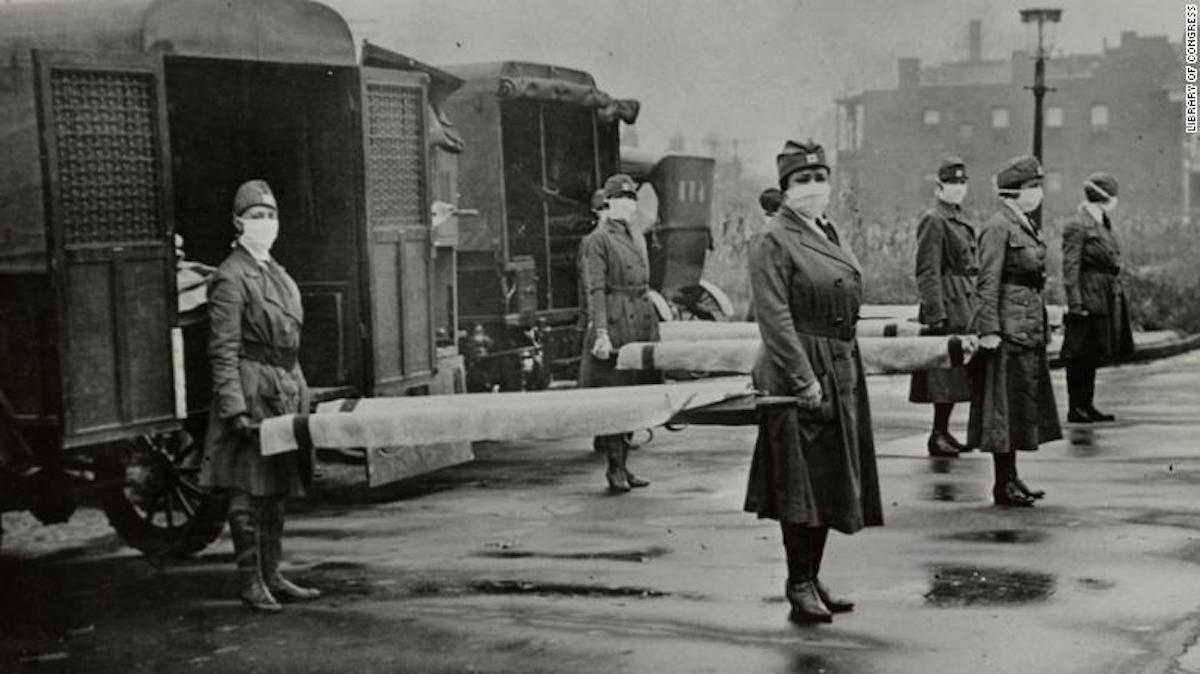A 113-year-old woman recovers from covid-19 1:36
(CNN) -
At this point in the coronavirus pandemic, with more than 32 million infected and more than 980,000 deaths worldwide, describing this moment as "unprecedented" may sound too upsetting.
This pandemic, however, is actually unprecedented: the last time we dealt with such a mysterious, unstoppable, and far-reaching pandemic was in 1918, when influenza devastated populations around the world.
What happened in the 1918 pandemic when students went to school
1918: Nurses tend to victims of a flu epidemic outdoors amid canvas tents in Lawrence, Massachusetts.
(Hulton Archive / Getty Images)
The 1918 flu pandemic killed 50 to 100 million people by 1919. There are disturbing parallels between the 1918 flu and the 2020 coronavirus pandemic. Both are illnesses with an alarming range of symptoms for which there is little treatment;
in both cases human behavior has been an obstacle to public health and outbreak focal points have become widespread, just to name a few.
For 102 years, flu scholars and infectious disease experts have tried to educate people in hopes of preventing future pandemics.
Yet here we are.
To be clear, the coronavirus to blame for the current pandemic is not a flu virus.
Yet the pandemics of 1918 and 2020 share similarities in terms of their basis in a new and formidable virus that swept the world in every aspect of society.
To learn the lessons of the 1918 flu, the missteps we've taken since, and our post-pandemic future, CNN spoke with three experts on the subject.
What experts are saying about the 1918 pandemic and the coronavirus
John M. Barry, author of "The Great Influenza: The Story of the Deadliest Pandemic in History";
Dr. Jeremy Brown, emergency room physician and author of "Influenza: The Hundred Year Hunt to Cure the Deadliest Disease in History";
and Gina Kolata, a science and medicine reporter for The New York Times and author of "Flu: The Story of the Great Influenza Pandemic of 1918 and the Search for the Virus That Caused it" spoke to CNN for this article.
These conversations have been edited and condensed for clarity.
Merck: The impact of the coronavirus, less than that of influenza 3:45
CNN: What are the lessons of the 1918 pandemic?
John M. Barry:
Number one, tell the truth.
Number two, non-pharmaceutical interventions work.
The Asian countries, New Zealand, Germany and Senegal have done an incredibly good job because of transparency.
But we have shown that the outbreak can really be controlled with non-pharmaceutical interventions (physical distancing and masks).
We have not done them in the US.
We have not adhered to them;
we have played with them.
Dr. Jeremy Brown:
There was a backlash against the use of masks in San Francisco in late 1918 and early 1919. People were essentially fed up.
There was a group of libertarians who suggested that it was a violation of their rights and freedoms to be forced to wear masks, and in fact ended up preventing the health board there from renewing the mandate to wear masks.
Young adults were more likely to die during the 1918 flu pandemic, in contrast to the current Covid-19 pandemic, in which the elderly face a higher risk of serious illness and death.
What happened was another spike in San Francisco in influenza cases in early 1919, and they went back to wearing masks.
The message is, perhaps, that things are not as novel as they might appear, and that human behavior in response to pandemics of this magnitude is actually quite predictable.
Gina Kolata:
Although we know exactly what the 1918 virus looks like, we still don't know why it was so deadly.
And here we have the coronavirus, and we know so much more, and we still don't really know why it is so deadly or what it is doing.
I think it's a very powerful lesson that you can think, "I know molecular biology, I know about viruses, I know how they replicate," and there may still be these diseases that you don't understand.
CNN: The experts in 1918 and infectious diseases have emphasized paying attention to history to prevent future pandemics.
Where do you think we've gone wrong since the flu in 1918?
Brown:
We have to be very careful saying, "Well, it was obvious, do this, do that."
But I think it was pretty clear that the next pandemic threat was going to be a virus and not a bacteria, fungus, or parasite.
Most people thought it would be a flu pandemic and I was one of them.
What I think we needed to spend more time on was considering what could be the flu and other things.
It doesn't really matter, because if we had planned in advance how we would handle an influenza pandemic, we would also have a game plan on how we would handle a pandemic from another virus.
Unfortunately, we know that funding for these things comes in waves.
Funding money is allocated based essentially on what is happening today.
Very little attention is paid to what may happen in the future, and we have become complacent with our belief that we have the ability to control everything.
We are all subject to the great extremes of the climate, but also to nature.
The women wore surgical-style cloth masks to protect against influenza.
If we had kept planning for the pandemic central, then I think we would have been in a much, much better place.
But every year you fund planning for a pandemic, you are saying not to fund anything else.
When there is no pandemic on the horizon, it is very easy to say, "Why don't we take these millions of dollars and invest them in curing Alzheimer's disease?"
CNN: How did the 1918 pandemic finally end, and how do you think the current pandemic will lessen?
Brown:
The 1918 flu went extinct in early 1919. Today, circulating flu viruses include a descendant of the early 1918 H1N1 virus. So we are actually exposed to a descendant of that early pandemic.
In general, infectious disease ends when people flee from it until it disappears and when all the people who are exposed to it have died from it, so there is no one else.
And when other people who are exposed survive and gain immunity, that gives you some protection.
We have seen those three effects throughout history in 1918, and today we will see some variant of that.
There is no doubt that we will see the end of covid-19.
The big question is, what will the cost be and when will it be?
CNN: Given what you know about the 1918 flu, what are you particularly concerned about right now?
Barry:
Most disturbingly, we know that the virus damages the heart and lungs, even if people don't have any symptoms.
It is likely to damage other organs even in people who have no symptoms.
So we don't know the long-term effects, if that damage will heal and if it will haunt them and affect their lives 10 or 25 years from now.
At an unspecified barbershop, a man receives a shave from a barber wearing a flu mask during the ongoing pandemic, Chicago, Illinois, 1918. (Chicago Sun-Times Photo / Chicago Daily News Collection / Chicago History Museum / Getty Images)
Brown:
What worries me the most is people's selfishness and this thought, "If I'm okay, that's all that matters."
I think the message we've seen is that people are selfish to a remarkable degree that I don't think we've seen before.
The selfishness of people and their inability to empathize with others who are not like them is one of the very, very disturbing aspects that the disease has highlighted.
I think this is a deeply ingrained part of American society.
Kolata:
I am concerned about society, employment, people who have lost everything and people who do not have enough to eat.
I worry about the children in school because distance learning doesn't work.
And college students who have to go to college remotely.
People who have just graduated cannot get jobs.
They are like a lost generation when they should start their careers.
I worry about people who haul long distances, they just never recover.
I worry about people who lose relatives.
CNN: Is there anything about the current pandemic that gives you hope?
Barry:
Trump is right about one thing: this virus will not go away;
will be here forever.
But I think that over time, people's immune systems will adjust with or without the vaccine.
It is probably not as dangerous in the future as it is now.
At least there is a good chance of that.
Brown:
First of all, people seem to get back to normal very quickly.
Now I think that's because infectious diseases were such a common occurrence at the turn of the century - we didn't have vaccines against diphtheria, measles, hepatitis, or meningitis, so waves of these diseases were very common in Europe and USA. People have been dealing with infectious diseases in their lives for centuries.
In 1918, they recovered relatively quickly.
With covid-19, I think it remains an open question whether there will be an economic rebound and, more importantly, an emotional rebound, in which we are reminded in ways that never before reminded us that we are subject to the whims of nature when it comes to disease.
Kolata:
Societies have somehow passed, recovered, and survived some pretty horrible pandemics in the past that were much worse than what we are going through now.
Now, at least, we have a chance to get a vaccine that can actually stop this virus before it spreads to the entire population and affects everyone who could be affected.
So, I have some hope.
covid-19 Influenza 1918






